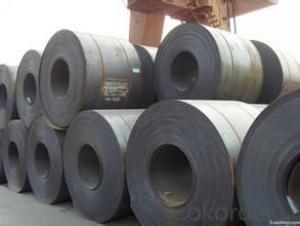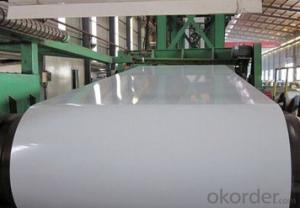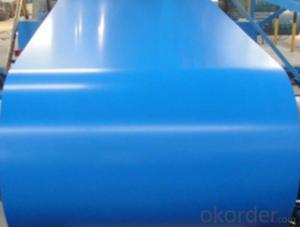Pre-Painted Galvanized Steel Coil/Construction Purposes/PPGI
- Loading Port:
- China main port
- Payment Terms:
- TT OR LC
- Min Order Qty:
- 25 m.t.
- Supply Capability:
- 1000 m.t./month
OKorder Service Pledge
OKorder Financial Service
You Might Also Like
Product Description
Product Name: China PPGI manufacturer/PPGI MILL
PPGI coils
PPGI steel coils
PPGI galvanized coils
PPGI zinc coated coils
Pre-painted galvanized steel coils
Color coated steel coils
Color coated steel coils
Red color/blue color steel coils
Color coated PPGI FOR metal roof
DX51D color coated corten steel coil(PPGI)
Prime prepainted galvanized steel coil
White color prepainted steel coils
Color steel coil for roofing material
Dx51d+z prepainted steel coil
Colorful galvanized steel coil
Specifications:
Grades: Q195-Q235 and SPCC, SPCD, SPCE, SGCC (DX51D+Z) and SGCD (DX52D+Z)
Thickness: 0.13 to 2.0mm
Width: 600 to 1200mm or customized
Coil inner diameter: 508 to 610mm
Coil weight: Customized
Color: RAL
Surface protection: PE, PVDF, SMP and HDP
Surface treatment: Chromate, oil/un-oil, bright finish, spangle and anti-finger print
Standards: JIS G3302, JIS G3312 and ASTM A653M/A924M 1998
Zinc coating weight: 60 to 275G/M
Features:
Nice corrosion-resistant: Zinc layer provides nice protection of pre-painted galvanized steel sheet
High heat resistant: Reflective surface of material aids in efficiently reflecting sunlight away and turn reducing amount of heat transmitted, thermal reflectivity converts into energy-saving.
Coating adhesive force of color-coated sheet is strong, which keeps color and luster novel for long.
Widely used in such field as architecture, electrical home appliances, furniture, communal facilities, communications and transportation.
PPGI prepainted sheets and coils
Product thickness: 0.135 to 2.0mm
Product width: 760 to 1250mm
Coil weight: 5 to 10 metric tons
Coil ID: 508mm
Coil OD: Max 1500mm
Coating type: PE
Standards: JIS G 3312, ASTM A755M, GB/T 12754, Q/CHG 2-2003, EN 10143, DIN 17162
Material: TDC51D, AZ150, SGCC, CGCC, SPCC195L, TSGCC, CCGI, Q195-Q235, SPCD, SPCE
Color: RAL
Zinc coating: 60 to 275G/M²
Application: Construction, hardware, home appliances, interior decoration and more.
NAME | PPGI | GALVANIZED | GALVALUME/ALUZINC |
CERTIFICATE | ISO9001:2008 | ||
| EN10142 | ASTM A653 | ASTM A792 |
| CGCC | SS GRADE33-80 | GRADE33-80 |
MODEL NO | 0.16MM-1.5MM*1250MM OR UNDER | (0.12-1.5)*1250MM OR UNDER | 0.16MM-1.5MM*1250MM OR UNDER |
| Steel coil | Steel coil | Steel coil |
| Hot rolled-cold rolled | Hot rolled-cold rolled | Hot rolled-cold rolled |
SURFACE | Mini/regular/big/zero spangle, | Mini/regular/big/zero spangle, | |
APPLICATION | Structural use ,roofing, commercial use, household appliance, industry, family | ||
SPECIAL | Wear resistant steel, high- strength - steel plate | ||


- Q: What is the role of steel coils in HVAC systems?
- Steel coils are an essential component in HVAC systems as they act as heat exchangers, allowing for efficient transfer of heat between the refrigerant and the surrounding air. They help to cool or heat the air as it passes through the system, contributing to the overall temperature control and comfort in indoor spaces.
- Q: I would like to know if steel is basically a very dense crystal, or if it is a different atomic structure
- Steel is made of billions, trillions of very small crystals. This is true of most metals. In order to see the crystal structure of steel, you usually need to cut a sample of it, grind and polish the cut face smooth, then etch the steel with a mixture of nitric acid and alcohol. Without polishing and etching the crystals aren't visible- it just looks like smooth solid metal. Also, in most cases the crystals are small enough that you need a microscope to see them clearly after etching.
- Q: What are the different grades of steel coils?
- There are various grades of steel coils available, including low carbon steel, medium carbon steel, high carbon steel, stainless steel, and galvanized steel coils. Each grade has specific properties and applications, making them suitable for different industries and purposes.
- Q: Can steel coils be rewound?
- Yes, steel coils can be rewound.
- Q: How are steel coils used in the production of shipbuilding components?
- Steel coils are used in the production of shipbuilding components as they are the primary raw material for manufacturing various structural and mechanical parts, such as hulls, decks, bulkheads, and frames. These coils are unwound, cut, shaped, and welded to form the required sections and profiles, providing the necessary strength and durability to withstand the harsh marine environment.
- Q: How do steel coil manufacturers handle custom orders?
- Steel coil manufacturers handle custom orders by following a systematic process that involves understanding the specific requirements of the customer, designing and producing the custom coils, and ensuring quality control throughout the manufacturing process. Firstly, when receiving a custom order, manufacturers must thoroughly understand the customer's specific needs. This involves detailed communication and collaboration with the customer to gather information about the desired specifications, dimensions, tolerances, and other special requirements. Manufacturers may also provide technical expertise and guidance to the customer to ensure that the custom order can be successfully produced. Once the requirements are clearly defined, manufacturers proceed with designing and engineering the custom steel coils. This involves utilizing advanced software and engineering tools to create detailed designs and specifications that meet the customer's unique needs. Manufacturers may also create prototypes or samples for the customer's approval before proceeding with full-scale production. After the design phase, manufacturers begin the production process. This typically involves sourcing the appropriate raw materials, such as steel coils of the required composition and thickness. The coils are then processed through various manufacturing stages, including cutting, shaping, and forming, to achieve the desired dimensions and shapes. Specialized equipment and machinery are used to ensure precision and accuracy throughout the production process. Quality control is a crucial aspect of handling custom orders. Manufacturers conduct rigorous inspections and testing procedures at various stages of production to ensure that the custom coils meet the customer's specifications and industry standards. This includes checking for dimensional accuracy, surface finish, mechanical properties, and any other specific requirements set by the customer. Manufacturers may also involve third-party inspection agencies or provide customers with test reports and certifications for quality assurance. Finally, once the custom steel coils are manufactured and pass all quality checks, they are carefully packaged and delivered to the customer. Manufacturers ensure proper packaging and shipping methods to prevent any damage during transit and ensure the coils reach the customer in optimal condition. In summary, steel coil manufacturers handle custom orders by closely collaborating with customers, designing and engineering specialized coils, ensuring quality control throughout the production process, and delivering the custom coils to the customer's satisfaction. This systematic approach allows manufacturers to meet the unique requirements of each customer and deliver high-quality custom steel coils.
- Q: How do steel coils contribute to energy efficiency in buildings?
- Steel coils contribute to energy efficiency in buildings by enhancing insulation and reducing heat transfer. These coils are often used in heating, ventilation, and air conditioning (HVAC) systems to efficiently regulate temperature. The coils help transfer heat effectively, allowing for better control over indoor climate and reducing the energy required for heating or cooling. Additionally, steel coils are durable and require less maintenance, making them a cost-effective solution for long-term energy efficiency in buildings.
- Q: hi i was doing a little history project on guns. i was just wondering if anyone could help me find out what material was used before steel and why this material wasnt as good as steel ( its faults)thanks for your help
- The most common was bronze, which was the strongest material that could be cast, at least until the industrial revolution. Until that time, furnaces which could reach temperatures hot enough to melt steel did not exist. The only way to work with steel would have been forging, which means hammering it into shape while red-rot. Obviously, this is not a very practical method for making large thick-walled cannons (though it was done on occasion. Small arms such as pistols and muskets could be easily made of steel by hand forging.) The most practical way to make cannons was pouring molten bronze which melts at significantly lower temperature than steel. Cast iron was also used. Note that Cast Iron contains 3%-7% carbon, compared to steel which only contains between 2% to 0.2% carbon. Due to the excessive carbon content of cast iron, it's melting point is about 500 degrees lower than steel enabling it to be melted with pre-industrial furnaces. Unfortunately, cast iron is also brittle, unlike steel or bronze. This means that a defective or cracked casting could easily explode, sending iron shrapnel everywhere. (Also, maiming and killing the gun crew, an experienced gun crew was as valuable as the cannon itself!) For this reason. Cast iron cannon were usually considered a cheap, risky alternative to expensive but durable bronze.
- Q: How are steel coils used in the production of storage tanks and silos?
- Due to their strength and durability, steel coils are essential in the production of storage tanks and silos. Typically made from high-quality steel, these coils undergo various manufacturing techniques to achieve the desired thickness and shape. In the production process, the steel coils are initially uncoiled and then cut into specific sizes and lengths to meet the requirements of the storage tank or silo design. Bending and rolling machines are then used to shape the coils into cylindrical sections, forming the main body of the tank or silo. After achieving the desired shape, the coils are welded together to create a continuous and secure seam. This welding process ensures leak-proof tanks and silos that can withstand the pressure exerted by the stored materials. Furthermore, steel coils play a crucial role in reinforcing the structure of storage tanks and silos. They are frequently utilized to construct the roofs, bottoms, and other structural components of these storage units. The strength and resilience of steel make it ideal for supporting the weight of the stored materials and resisting external forces. Additionally, steel coils can be coated or treated with protective materials to enhance their resistance to corrosion and extend their lifespan. This is particularly important for storage tanks and silos that store corrosive substances or are exposed to harsh environmental conditions. In conclusion, steel coils are a fundamental element in the production of storage tanks and silos, providing the necessary strength, durability, and structural integrity required for these storage units.
- Q: So...I'm learning about how steel is made and I'm wondering if there is a more environmentally friendy method. I view it as unfriendly b/c of the oxygen that is injected when the steel is in the blast furnace or electric arc furnace. This oxygen bonds w/ the carbon to produce CO and CO2. THis is necessary to reduce the amount of carbon content to produce harder steels. So what other methods are there that can be used w/o having to end up w/ co and co2? thanks
- From what I understand of it, US steel is better as the steel is more recycled than Canadian, so a lot of that oxygen / CO2 has already taken place compared to working from ore. The second reason US steel is environmentally ahead of Canadian is that US tends to use Electric Arc, while Canadian uses Basic Oxygen, Basic Oxygen uses more energy than electric arc, and I think it also uses more oxygen, but I would suspect that oxygen that it uses is 'waste oxygen' and not converted into Co2 because the Co2 process is limited by the carbon, and steel only has so much carbon.
Send your message to us
Pre-Painted Galvanized Steel Coil/Construction Purposes/PPGI
- Loading Port:
- China main port
- Payment Terms:
- TT OR LC
- Min Order Qty:
- 25 m.t.
- Supply Capability:
- 1000 m.t./month
OKorder Service Pledge
OKorder Financial Service
Similar products
Hot products
Hot Searches
Related keywords




























